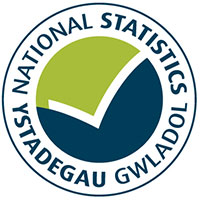Monthly data on employment, unemployment and economic inactivity.
This is not the latest release in the series: Labour market overview
Headline labour market indicators, 3 months to November 2023
This headline provides a summary of the latest key statistics relating to the Welsh labour market. It includes data based on experimental statistics published by the Office for National Statistics (ONS) using Labour Force Survey (LFS), HMRC Pay as You Earn Real Time Information (PAYE RTI), and claimant count data.
Because of increased uncertainty around the LFS estimates, the ONS have published an alternative series of estimates of employment, unemployment and economic inactivity as experimental statistics. The experimental figures were derived using growth rates from PAYE RTI and the Claimant Count for the periods from May to July 2023 onwards. This is to provide a more holistic view of the state of the labour market while the LFS estimates are uncertain.
Further information on the experimental statistics are available in the methodology report published by ONS.
ONS have outlined the steps they are planning to take in order to address the current LFS challenges in their latest statement on the Labour Force Survey, with the aim to reintroduce LFS estimates in February 2024.
Employment rate
Figure 1: Employment rate, 3 months to November 2013 to the 3 months to November 2023
Description of Figure 1: Line chart showing the employment rate in the UK has generally been higher than in Wales over the last 10 years. Data from the period May to July 2023 is based on adjusted experimental labour market statistics.
Source: Welsh Government analysis of Labour Force Survey; HMRC PAYE RTI and Claimant count data.
Wales
The adjusted experimental employment rate in Wales was 72.6%. This is unchanged on the quarter and up 0.3 percentage points on the year.
UK
The UK adjusted experimental employment rate was 75.8%. This is up slightly on the quarter and up 0.2 percentage points on the year.
Unemployment rate
Figure 2: Unemployment rate, 3 months to November 2013 to the 3 months to November 2023
Description of Figure 2: Line chart showing the unemployment rate has decreased overall in both Wales and the UK over the last 10 years. Data from the period May to July 2023 is based on adjusted experimental labour market statistics.
Source: Welsh Government analysis of Labour Force Survey; HMRC PAYE RTI and Claimant count data.
Wales
The adjusted experimental unemployment rate in Wales was 4.8%. This is unchanged on the quarter and up 1.4 percentage points on the year.
UK
The UK adjusted experimental unemployment rate was 4.2%. This is unchanged on the quarter and up 0.6 percentage points on the year.
Economic inactivity rate
Figure 3: Economic inactivity rate, 3 months to November 2013 to the 3 months to November 2023
Description of Figure 3: Line chart showing the economic inactivity rate has generally decreased in the UK over the last 10 years but has seen an overall increase since early 2020. In Wales, the rate has fluctuated over this time but generally remains above the UK rate. Data from the period May to July 2023 is based on adjusted experimental labour market statistics.
Source: Welsh Government analysis of Labour Force Survey; HMRC PAYE RTI and Claimant count data.
Wales
The adjusted experimental economic inactivity rate in Wales was 23.7%. This is unchanged on the quarter and down 1.4 percentage points on the year.
UK
The UK adjusted experimental economic inactivity rate was 20.8%. This is down slightly on the quarter and down 0.7 percentage points on the year.
Monthly paid employees and earnings from Pay As You Earn Real Time Information
The Office for National Statistics and HM Revenue & Customs publish data for Wales on payrolled employees, mean pay, aggregate pay and single month estimates for median pay.
Paid Employees
Figure 4: Payrolled Employees, Wales, December 2018 to December 2023
Description of Figure 4: A line chart showing the trend in the number of paid employees over the past few years has been generally increasing despite a steep decrease between March 2020 and July 2020.
Source: Welsh Government analysis of Pay As You Earn Real Time Information, Office for National Statistics and HMRC
The number of paid employees has generally increased in recent years, but fell during the pandemic. The number of paid employees returned to pre-pandemic levels in July 2021, and has remained above since.
Early estimates for December 2023 indicate that the number of paid employees in Wales has decreased by 700 (0.1%) over the month to 1.31 million.
At a UK level, early estimates for December 2023 showed a monthly decrease of 24,000 (0.1%).
Other detailed breakdowns of paid employees including by local authority, by age and by sector are published by the Office for National Statistics.
Further information
The Office for National Statistics (ONS) indicate that there is an increasing challenge to maintain response rates for the Labour Force Survey and that headline numbers for employment are starting to vary from other labour market data sources. In addition to the Office for National Statistics blog on this topic, please see the latest Chief Statistician’s update on understanding and managing the impact of these challenges for labour market data in Wales.
Contact
Joe Davies
Email: labourmarket.stats@gov.wales
Rydym yn croesawu gohebiaeth yn Gymraeg / We welcome correspondence in Welsh.

